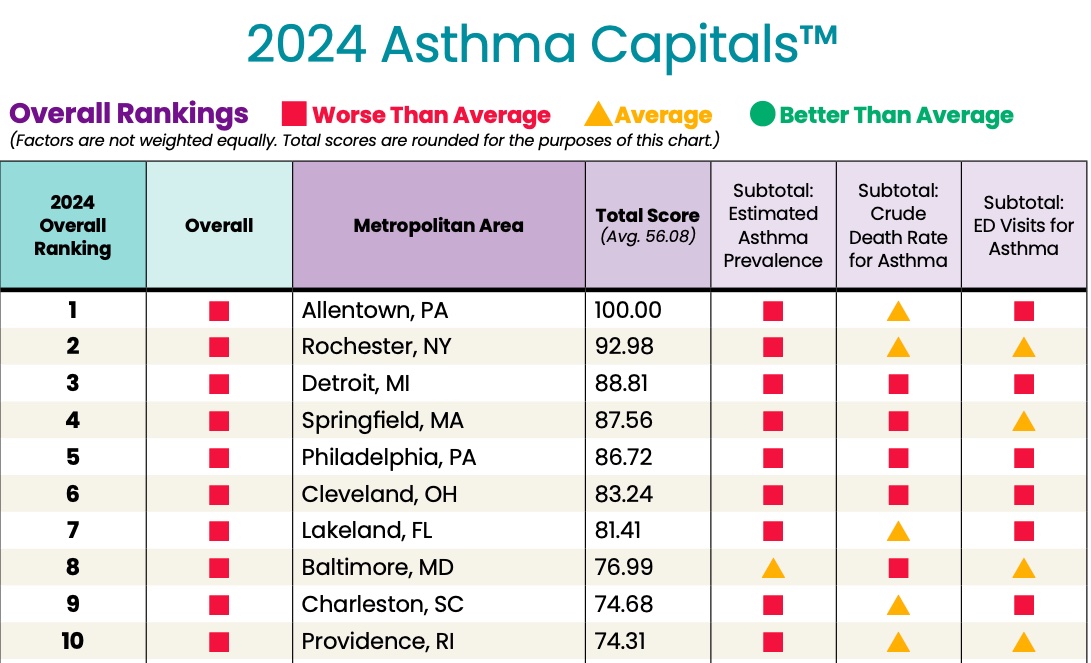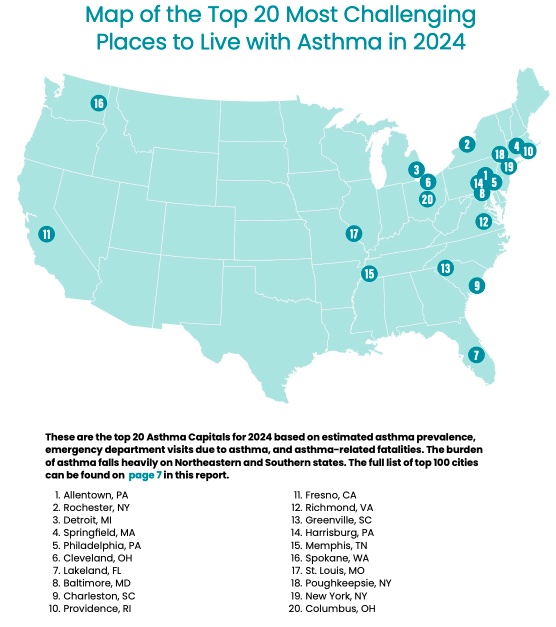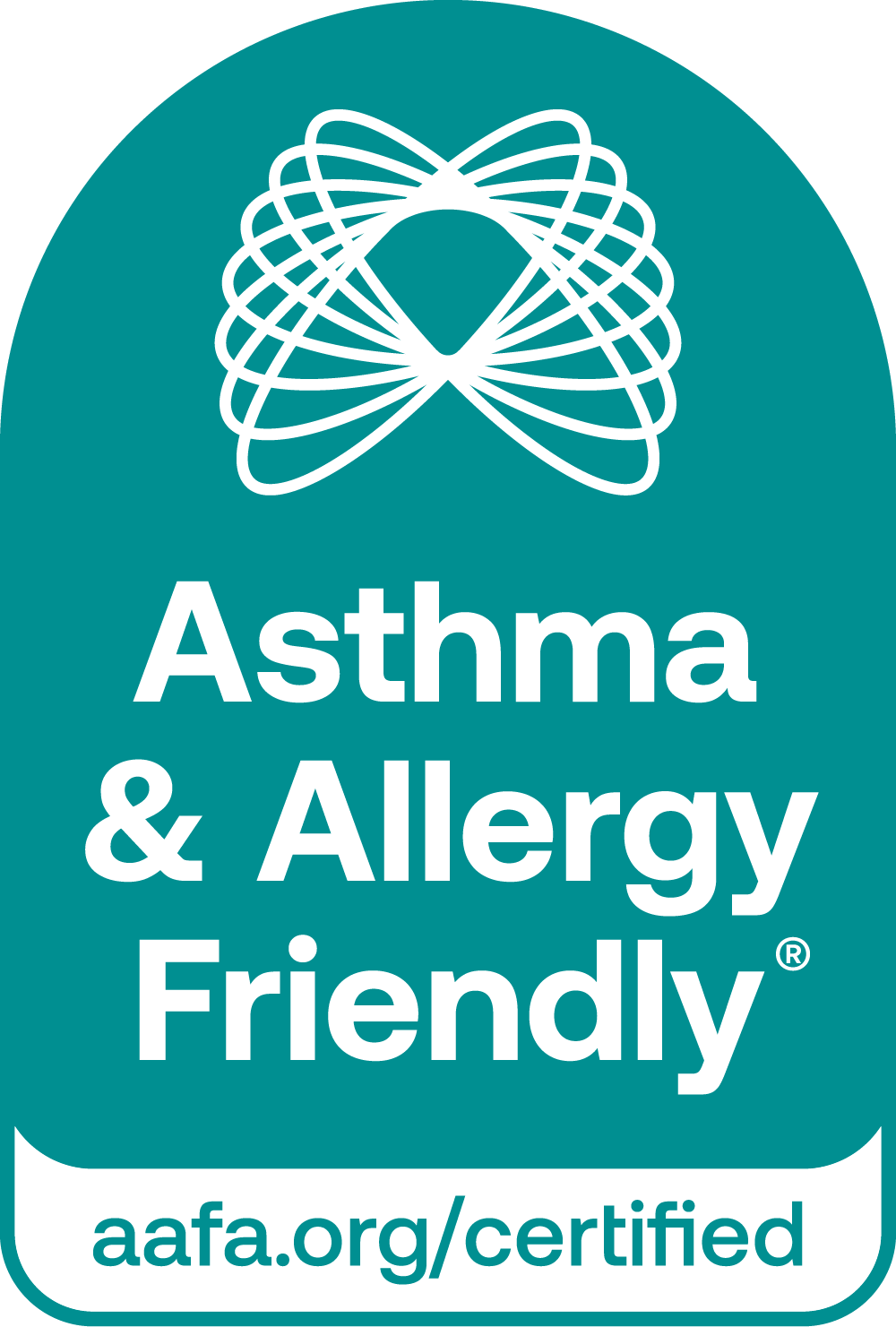Our partner in the Asthma & Allergy Friendly® Certification Program, the Asthma and Allergy Foundation of America (AAFA) has released its 2024 Asthma Capitals™ report, which highlights how asthma outcomes are influenced by where people live. This report ranks the 100 largest U.S. cities based on how challenging they are for people with asthma, providing a call to action for creating healthier environments. Nearly 28 million Americans live with asthma, and factors such as access to healthcare, clean air, and economic stability play a significant role in managing the condition.
The report ranks cities based on three key health outcomes:
- Asthma prevalence
- Emergency department visits due to asthma
- Asthma-related deaths
This year’s report also emphasizes several risk factors, including poverty, air quality, and access to medical care, which contribute to disparities in asthma outcomes.

September: Asthma Peak Month
AAFA releases the Asthma Capitals™ report in September to coincide with Asthma Peak Month, a period when asthma attacks and hospitalizations increase. The third week of September, known as Asthma Peak Week, is especially challenging due to high levels of ragweed pollen, mold, respiratory illnesses, and poor indoor air quality in schools. This time of year also coincides with wildfire-related air pollution and extreme weather events like hurricanes, which exacerbate asthma triggers.
Indoor Air Quality: A Major Risk Factor for Asthma
One of the critical risk factors highlighted in AAFA’s 2024 Asthma Capitals™ report is poor indoor air quality (IAQ). We spend roughly 90% of our time indoors—whether at home, work, or school—making the quality of the air we breathe indoors vital to managing asthma. Indoor air can be up to five times more polluted than outdoor air, with common asthma triggers like dust mites, pet dander, mold, and volatile organic compounds (VOCs) often concentrated inside buildings. Poor ventilation, chemical emissions from cleaning products or building materials, and high humidity levels can worsen IAQ and trigger asthma attacks. Reducing exposure to these pollutants is key to managing asthma symptoms. The Asthma & Allergy Friendly® Certification Program plays an essential role in improving IAQ by CERTIFYING products, from air purifiers to cleaning products, that meet stringent standards for reducing allergens and irritants, helping to create healthier indoor environments.
Reducing Health Disparities: A Focus on Allentown, Pennsylvania
For the second year in a row, Allentown, Pennsylvania, was ranked as the #1 Asthma Capital. Like many other cities in the report, Allentown faces significant challenges related to poverty, air quality, and limited access to care. These factors contribute to health disparities that make managing asthma more difficult for residents.
Through AAFA’s Health Equity Advancement and Leadership (HEAL) Program, efforts are being made to address these disparities. The program provides funding and resources to local pilot projects in high-burden communities like Allentown. This year, HEAL will focus on developing a community-based asthma management program for older adults, building new care pathways in collaboration with local healthcare providers.

Taking Action Through Advocacy and Policy
Advocacy is a key component of AAFA’s work to reduce the burden of asthma. The 2024 Asthma Capitals™ report highlights major risk factors that influence asthma outcomes and encourages individuals to get involved in advocacy at the state and local levels. AAFA supports a “health in all policies” approach, recognizing that decisions in housing, education, and the environment can directly impact health.
AAFA provides resources for advocates, including tips for contacting legislators, sample letters, and resolutions to raise awareness during Asthma Peak Week. By engaging with policymakers, communities can help promote policies that improve asthma outcomes nationwide.
For more details on the 2024 Asthma Capitals™ report, visit the AAFA website.
